芦荟大黄素
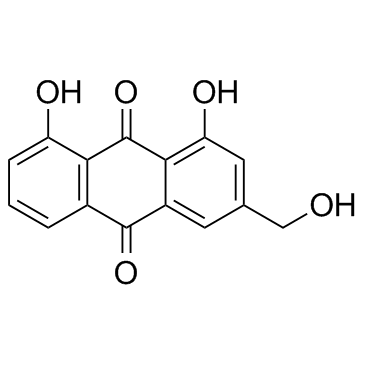
芦荟大黄素结构式

|
常用名 | 芦荟大黄素 | 英文名 | Aloeemodin |
|---|---|---|---|---|
| CAS号 | 481-72-1 | 分子量 | 270.237 | |
| 密度 | 1.6±0.1 g/cm3 | 沸点 | 568.8±50.0 °C at 760 mmHg | |
| 分子式 | C15H10O5 | 熔点 | 223-224°C | |
| MSDS | 中文版 美版 | 闪点 | 311.9±26.6 °C | |
| 符号 |

GHS07 |
信号词 | Warning |
芦荟大黄素用途芦荟大黄素(Aloe emodin)是从芦荟叶中提取出的羟基蒽醌,已被证明体外和体内抗肿瘤活性。 |
| 中文名 | 芦荟大黄素 |
|---|---|
| 英文名 | Aloe emodin |
| 中文别名 | 1,8-二羟基-3-(羟基甲基)蒽醌 | 1.8-二羟基-3-羟甲基蒽醌 | 1,8-二羟基-3-羟甲基蒽醌 | 芦荟泻素 |
| 英文别名 | 更多 |
| 描述 | 芦荟大黄素(Aloe emodin)是从芦荟叶中提取出的羟基蒽醌,已被证明体外和体内抗肿瘤活性。 |
|---|---|
| 相关类别 | |
| 参考文献 |
| 密度 | 1.6±0.1 g/cm3 |
|---|---|
| 沸点 | 568.8±50.0 °C at 760 mmHg |
| 熔点 | 223-224°C |
| 分子式 | C15H10O5 |
| 分子量 | 270.237 |
| 闪点 | 311.9±26.6 °C |
| 精确质量 | 270.052826 |
| PSA | 94.83000 |
| LogP | 3.38 |
| InChIKey | YDQWDHRMZQUTBA-UHFFFAOYSA-N |
| SMILES | O=C1c2cccc(O)c2C(=O)c2c(O)cc(CO)cc21 |
| 外观性状 | 橙色针状结晶(由甲苯中)。易溶于热乙醇,在苯及乙醚中呈黄色,在氨水和硫酸中呈绯红色,属蒽醌类化合物,在酸性溶液中被还原则生成蒽酚及其互变异构体的蒽酮。熔点:223~224℃ |
| 蒸汽压 | 0.0±1.6 mmHg at 25°C |
| 折射率 | 1.746 |
| 储存条件 | 2-8°C 密封保存,放置于通风、干燥地方,避免于其他氧化物接触。 |
| 稳定性 | 按规格使用和贮存,不会发生分解,避免与氧化物接触 |
| 分子结构 | 1、 摩尔折射率:68.88 2、 摩尔体积(m3/mol):169.7 3、 等张比容(90.2K):520.5 4、 表面张力(dyne/cm):88.4 5、 极化率(10 -24cm 3):27.30 |
| 计算化学 | 1.疏水参数计算参考值(XlogP):1.8 2.氢键供体数量:3 3.氢键受体数量:5 4.可旋转化学键数量:1 5.互变异构体数量:24 6.拓扑分子极性表面积94.8 7.重原子数量:20 8.表面电荷:0 9.复杂度:421 10.同位素原子数量:0 11.确定原子立构中心数量:0 12.不确定原子立构中心数量:0 13.确定化学键立构中心数量:0 14.不确定化学键立构中心数量:0 15.共价键单元数量:1 |
| 更多 | 1. 性状:橙色针状结晶 2. 密度(g/ m3,25/4℃):未确定 3. 相对蒸汽密度(g/cm3,空气=1):未确定 4. 熔点(ºC):223-224 5. 沸点(ºC,常压):未确定 6. 沸点(ºC,5.2kPa):未确定 7. 折射率:未确定 8. 闪点(ºC):未确定 9. 比旋光度(º):未确定 10. 自燃点或引燃温度(ºC):未确定 11. 蒸气压(kPa,25ºC):未确定 12. 饱和蒸气压(kPa,60ºC):未确定 13. 燃烧热(KJ/mol):未确定 14. 临界温度(ºC):未确定 15. 临界压力(KPa):未确定 16. 油水(辛醇/水)分配系数的对数值:未确定 17. 爆炸上限(%,V/V):未确定 18. 爆炸下限(%,V/V):未确定 19. 溶解性:未确定 |
|
芦荟大黄素毒理学数据: 致突变数据:微生物机体TEST系统突变:细菌-鼠伤寒沙门氏杆菌:100 ug/plate; 微生物机体TEST系统突变:细菌-鼠伤寒沙门氏杆菌:10 ug/plate; 非程序DNA synthesisTEST系统:啮齿动物-鼠肝:10mg/L; 微testTEST系统:啮齿动物-小鼠淋巴细胞:20umol/L; 形态transformationTEST系统:啮齿动物-小鼠成纤维细胞:3mg/L; 哺乳动物体细胞突变cellsTEST系统:啮齿动物-小鼠淋巴细胞:55500nmol/L; 细胞遗传学analysisTEST系统:啮齿动物-仓鼠卵巢:18750ug/L; 哺乳动物体细胞突变cellsTEST系统:啮齿动物-仓鼠肺:10mg/L。 芦荟大黄素生态学数据: 通常对水是不危害的,若无政府许可,勿将材料排入周围环境。 |
| 符号 |

GHS07 |
|---|---|
| 信号词 | Warning |
| 危害声明 | H315-H319-H335 |
| 警示性声明 | P261-P305 + P351 + P338 |
| 个人防护装备 | dust mask type N95 (US);Eyeshields;Gloves |
| 危害码 (欧洲) | Xi |
| 风险声明 (欧洲) | R36/37/38:Irritating to eyes, respiratory system and skin . |
| 安全声明 (欧洲) | S26-S36 |
| 危险品运输编码 | NONH for all modes of transport |
| WGK德国 | 3 |
| RTECS号 | CB6712200 |
| 芦荟大黄素上游产品 7 | |
|---|---|
| 芦荟大黄素下游产品 10 | |
|
Correlation between reduction potentials and inhibitions of Epstein-Barr virus activation by anthraquinone derivatives.
Bioorg. Med. Chem. Lett. 18 , 4106-9, (2008) As a continuation of studies using natural and synthetic products as cancer chemopreventive agents, we used cyclic voltammetry to examine the reduction-oxidation potentials of methylated emodin deriva... |
|
|
In vitro inhibition of Streptococcus mutans biofilm formation on hydroxyapatite by subinhibitory concentrations of anthraquinones.
Antimicrob. Agents Chemother. 51 , 1541-4, (2007) We report that certain anthraquinones (AQs) reduce Streptococcus mutans biofilm formation on hydroxyapatite at concentrations below the MIC. Although AQs are known to generate reactive oxygen species,... |
|
|
High-affinity, non-nucleotide-derived competitive antagonists of platelet P2Y12 receptors.
J. Med. Chem. 52 , 3784-93, (2009) Anthraquinone derivatives related to the moderately potent, nonselective P2Y(12) receptor antagonist reactive blue 2 (6) have been synthesized and optimized with respect to P2Y(12) receptor affinity. ... |
| EINECS 207-571-7 |
| Aloe emodin |
| MFCD00017373 |
| 1,8-Dihydroxy-3-(hydroxymethyl)anthracen-9,10-dion |
| 1,8-Dihydroxy-3-(hydroxymethyl)anthraquinone |
| ALOE-EMODIN |
| Aloeemodin:9,10-Anthracenedione,1,8-dihydroxy-3-(hydroxymethyl)-, |
| Aloeemodin |
| 1,8-Dihydroxy-3-(hydroxymethyl)anthraquinone,3-Hydroxymethylchrysazine,Aloe-emodin |
| 3-Hydroxymethylchrysazine |
| EMODINE |
| 1,8-dihydroxy-3-(hydroxymethyl)anthracene-9,10-dione |
| Rhabarberone |
| 1,8-Dihydroxy-3-(hydroxymethyl)anthra-9,10-quinone |
| 3-Hydroxymethylchrysazin |
| 1,8-Dihydroxy-3-(hydroxymethyl)anthraquinone,3-Hydroxymethylchrysazine |
| 1,8-Dihydroxy-3-(hydroxymethyl)-9,10-anthraquinone |
| Diacerein impurity B |
| 9,10-Anthracenedione, 1,8-dihydroxy-3-(hydroxymethyl)- |

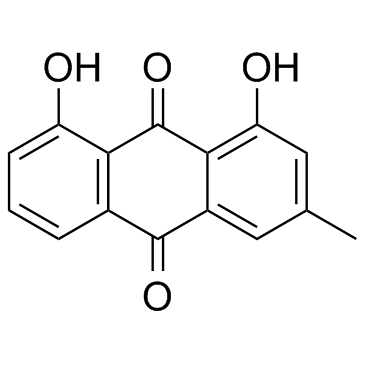 CAS号481-74-3
CAS号481-74-3 CAS号65615-58-9
CAS号65615-58-9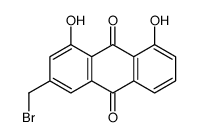 CAS号72036-12-5
CAS号72036-12-5 CAS号1415-73-2
CAS号1415-73-2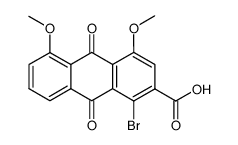 CAS号72049-23-1
CAS号72049-23-1 CAS号2161-90-2
CAS号2161-90-2 CAS号124010-11-3
CAS号124010-11-3 CAS号478-43-3
CAS号478-43-3 CAS号613-12-7
CAS号613-12-7![3-[[(2R,3R,4R,5S,6R)-3-amino-4,5-dihydroxy-6-(hydroxymethyl)oxan-2-yl]oxymethyl]-1,8-dihydroxyanthracene-9,10-dione结构式](https://image.chemsrc.com/caspic/244/102831-03-8.png) CAS号102831-03-8
CAS号102831-03-8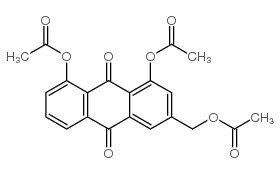 CAS号25395-11-3
CAS号25395-11-3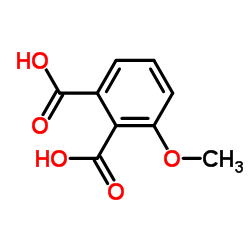 CAS号14963-97-4
CAS号14963-97-4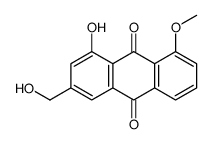 CAS号72049-14-0
CAS号72049-14-0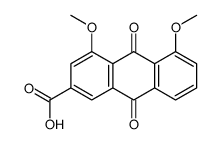 CAS号72049-24-2
CAS号72049-24-2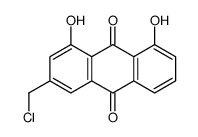 CAS号75694-01-8
CAS号75694-01-8
